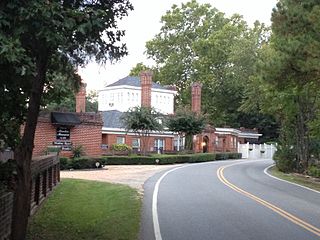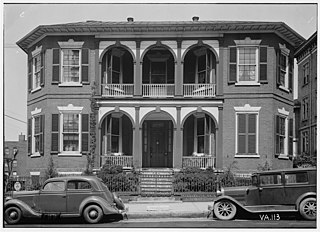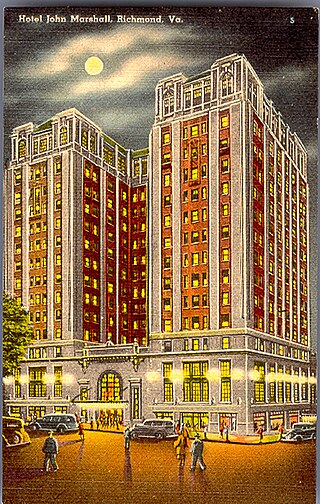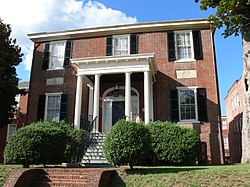
Hollywood Cemetery is a historic rural cemetery located at 412 South Cherry Street in the Oregon Hill neighborhood of Richmond, Virginia. It was established in 1847 and designed by the landscape architect John Notman. It is 135-acres in size and overlooks the James River. It is the only cemetery other than Arlington National Cemetery that contains the burials of two United States Presidents, James Monroe and John Tyler.

Broad Street is a 15-mile-long (24 km) road located in the independent city of Richmond, Virginia, and adjacent Henrico County. Broad Street is significant to Richmond due to the many commercial establishments that have been built along it throughout Richmond's history. From downtown through miles into the suburbs, the street is largely dedicated to retailing and offices, including regional and neighborhood shopping centers and malls.
Thalhimers was a department store chain in the Southern United States. Based in Richmond, Virginia, the chain at its peak operated dozens of stores in Virginia, North Carolina, South Carolina, and one store in Memphis, Tennessee. Thalhimer's traditions were most notable during the holiday season with visits from the sticker-distributing Snow Bear and, in later years, the arrival of Lego Land at the downtown Richmond store.

Swannanoa is an Italian Renaissance Revival villa built in 1912 by millionaire and philanthropist James H. Dooley (1841–1922) above Rockfish Gap on the border of northern Nelson County and Augusta County, Virginia, in the US. It is partially based on buildings in the Villa Medici, Rome.

Buildings, sites, districts, and objects in Virginia listed on the National Register of Historic Places:

The Franklin and Armfield Office, which houses the Freedom House Museum, is a historic commercial building in Alexandria, Virginia. Built c. 1810–1820, it was first used as a private residence before being converted to the offices of the largest slave trading firm in the United States, started in 1828 by Isaac Franklin and John Armfield. Another source, using ship manifests in the National Archives, gives the number as "at least 5,000".

The Ellen Glasgow House, also known as the Branch-Glasgow House, is a historic house at 1 West Main Street in Richmond, Virginia. Built in 1841, it is nationally significant as the home of writer Ellen Glasgow (1873–1945) from 1887 until her death. It was declared a National Historic Landmark in 1971.

Sabine Hall is a historic house located near Warsaw in Richmond County, Virginia. Built about 1730 by noted planter, burgess and patriot Landon Carter (1710–1778), it is one of Virginia's finest Georgian brick manor houses. Numerous descendants served in the Virginia General Assembly. It was added to the National Register of Historic Places in 1969, and declared a National Historic Landmark in 1970. At the time of its National Register listing, it was still owned by Carter / Wellford descendants.

This is a list of the National Register of Historic Places listings in Albemarle County, Virginia.

This is a list of the National Register of Historic Places listings in Henrico County, Virginia.

This is a list of the National Register of Historic Places listings in Spotsylvania County, Virginia.

Dominion Energy Center is a performing arts center in Richmond, Virginia that houses a number of venues including the historic Carpenter Theatre, Libby S. Gottwald Playhouse, Bob & Sally Mooney Hall, and the Genworth BrightLights Education Center. The theatre was formerly known as Richmond CenterStage.

Mankin Mansion, also known as Brickworks or as Irvin Place, was built in 1924 as a home and showplace by and for Edward Thurston Mankin, a brick manufacturer. The architecture of the mansion, inside and out, and of walls, benches, and structures on the grounds, includes many features ingeniously implemented in brick.

The Cathedral of the Sacred Heart in Richmond, Virginia, is the seat of the Roman Catholic Diocese of Richmond. The property is located along North Laurel Street at 823 Cathedral Place, facing Monroe Park one block north of Main Street. Construction of the cathedral was begun in 1903, financed by donations of Thomas Fortune Ryan and his wife; it was the only cathedral at that time known to be constructed by the exclusive patronage of a single family.

Violet Bank is a historic plantation house and museum in Colonial Heights, Virginia. It was listed on the National Register of Historic Places in 1974.

Strawberry Hill is a historic home located in Petersburg, Virginia, built by tobacco warehouse owner, William Barksdale, in 1792. Strawberry Hill, designed with a tripartite Palladian form, is an early example of a Virginia dwelling built in the neoclassical style and includes several notable architectural features. It is now an inn and event venue.

Hancock–Wirt–Caskie House, also known as The William Wirt House, is a historic home located in Richmond, Virginia. It was built in 1808–09, and is a two-story, seven-bay Federal-era brick dwelling with a hipped roof. The three bays on either side of the entrance are formed into octagonal-ended or three-sectioned bow front projections with a wooden, two-level porch arcade screening the central space. It has a central hall plan with an octagonal room on the south and a rectangular room behind and a larger single room across the hall. In 1816, William Wirt (1772–1834) purchased the house and lived there until 1818, when he moved to Washington as Attorney General of the United States under James Monroe. Formerly serving as the headquarters of the Richmond Chapter of the American Red Cross, the house is now a private residence. The last business to occupy this house was the law firm of Bowles and Bowles. The house bears a strong resemblance to Point of Honor in Lynchburg, Virginia.

Bolling Haxall House, also known as the Woman's Club, is a historic residential building located in Richmond, Virginia. It was built by Bolling Walker Haxall in 1858 and is a three-story Italian Villa style dwelling of sandstone-colored stucco, scored to imitate ashlar. It features a projecting central entrance on the front facade, a raised portico supported by four fluted columns, and an elaborate double-bracketed, dentiled cornice. An auditorium was added in 1916, after the home's acquisition by the Woman's Club in 1900.

The Grace Street Commercial Historic District is a national historic district located in Richmond, Virginia. The district encompasses 93 contributing buildings located in downtown Richmond. The buildings reflect the core of the city's early 20th-century retail development and the remnants of a 19th-century residential neighborhood. The buildings are in a variety of popular 19th-century and early 20th-century architectural styles, including Classical Revival, Mission Revival, International Style, and Colonial Revival. Notable buildings include the Administration and Equipment Building for the Chesapeake & Potomac Telephone Company (1929), Thalhimer's Department Store, Atlantic Life Building (1950-1959), Miller & Rhoads Department Store, Berry-Burk Building, former W. W. Foster Studios (1927), Bank of Virginia (1949), Investment Realty Company building (1930), W.T. Grant Store (1939), Hotel John Marshall (1927), Franklin Federal Savings and Loan building (1954), and the Tompkins House (1820). Located in the district and separately listed are the Loew's Theatre, Centenary United Methodist Church, Joseph P. Winston House, Central National Bank, and National Theater.

Marburg is a historic home located in the Carillon/Byrd Park area of Richmond, Virginia. It is the oldest standing residence in this area of Richmond, predating nearby Maymont by 4 years. The house was slated for demolition in 2013 to make way for 6 new homes but was saved by an ardent group of preservationists and the Historic Richmond Foundation. The redesigned development will now incorporate and encircle the existing house. An exterior restoration was completed in 2015 returning the house to its original colors after being stark white for many years. The barn red roof color was also restored. Two antebellum structures survive on this property: a 2-room servant cottage and a kitchen, both of which pre-date the house itself by over 30 years. As of February 2021, the house and dependencies have been repainted white with green shutters and roof, retaining a classic feel amongst the newer homes built around it.
























